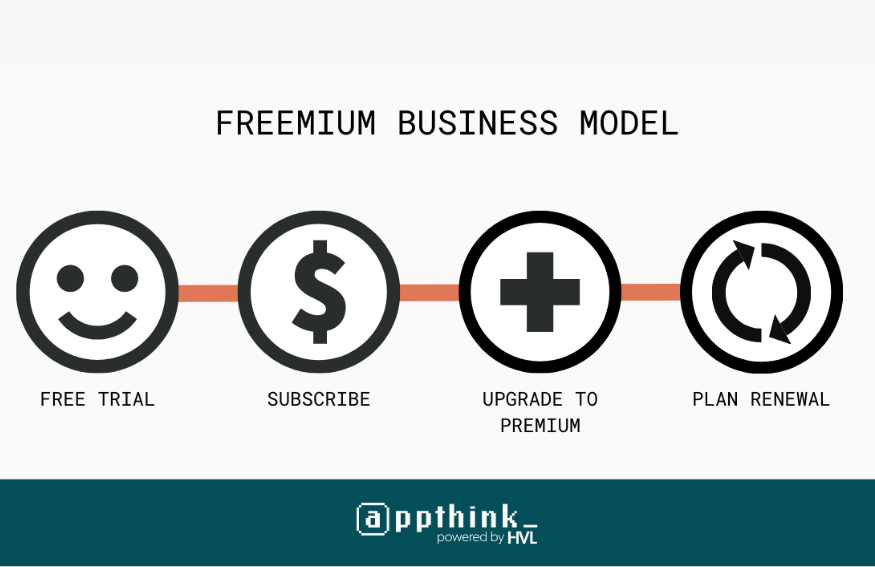Before committing to a new product or service, consumers want to know the value they’d get from it. Businesses spend time, effort, and money on marketing campaigns. If those efforts don’t make consumers feel confident buying a product or service, what is the best remedy for getting consumers to use your app?
The freemium revenue model can be an excellent solution for this issue. It allows the business to get new customers for a lower cost. To give you a better idea, we will discuss the freemium model in detail and let you know the pros and cons.
You will also see the best freemium model examples. Let’s start by understanding the basic definition of the freemium model.
What is the Freemium Revenue Model?
A freemium model for an application allows users to experience the app for no initial cost-free! Companies use the freemium model to divide consumers into two categories -a free tier or a premium tier. While both categories can access the service, the free tier can only use limited features.
Premium users can access extra features by paying for them. The primary goal of the freemium model is to bring down the cost of customer acquisition for a business.
It allows a decrease in spending on sales and marketing campaigns because the consumers are already using the app. The business can focus on highlighting its products’ value inside of the app for further revenue.
Why Do Businesses Prefer Using the Freemium Model?
The freemium model allows users to learn more about the product and its capabilities before they invest in it. Free-tier users help builds an organic lead-nurturing environment. This gives the business new customers at a lower cost. Once the free-tier users start reaching their account limits, they can decide whether to switch to a premium account.
Since users have an idea about the product and its value, they are more likely to convert. The free-tier user converts to a premium user because they are already using your product. Hence, it reduces customer acquisition and retention costs.
How to Implement the Freemium Acquisition Model?
As you design the product, think about how to set the free version apart from the paid one. Manage the separation of the two versions by using some limitations. For example, by offering better elements in the premium tier. This helps to maximize the freemium acquisition model.
Here are three examples you can try.
- Limitations: Give access to extra features, improved functionality of features, or access to ad-free versions for premium users. Gaming applications use this method.
- Storage Limits: Fix the quota for monthly credits or any other features of the app, allowing the user to know what they can get from the product but leaving them to come back for more.
- Limited Support: Free-tier users can only have limited customer support and resource access.
Remember that setting limitations for your goods or services should encourage customers to want more. By organizing limitations, users can see the core value of the business. This helps you to understand your customer’s needs and your product’s value. Strike the perfect balance.
Key Performance Indicators for the Freemium Business Model
The freemium business model allows you to acquire new customers. You will need to use metrics to measure its efficiency. There are various KPIs that you can factor in to know if the freemium model is working for your business. Let’s go over them to get a better idea.
Measuring Acquisition Costs
The whole concept of the freemium model is to acquire new customers at the lowest cost to the business. This KPI is the CAC. The (CAC) customer acquisition cost, is the amount you spend on acquiring customers during a particular period.
Your CAC is lowest for freemium customers. Your free-tier organic growth should come through referrals and word of mouth. Keeping your acquisition budget low helps a business to convert current customers into premium users. This saves time and money.
Measuring Retention Rate
Retaining old clients is equally important as finding new ones. The customer churn rate is an essential KPI since it tells you how well you keep your customers. The formula for measuring the retention rate is:
(Customer lost in a period ÷ Total Customers at the Start of time) x 100
The Churn rate will give you an idea of the rate at which your customers cancel their subscriptions to the app. While there is no way to please every customer, keeping the churn rate as low as possible is a goal. This KPI is important not only for freemium but for other business models as well.
Product Stickiness Rate
This metric is a ratio between the number of active users over a month and those that use the product daily. It is important for the freemium model since it gives clues to the product’s core value. It helps you understand the features that are essential for your customers. You can use this information to give users a preview of these valuable core features during the free version. It will help entice free users to become premium users.
Examples of Companies That Use the Freemium Model
We have all experienced a freemium product at some point. We might use it at our job for collaboration purposes or to perform other relevant tasks. Below are well-known services that helped freemium become a mainstream business model.
Slack
Slack is a popular chat application that people use as a communication tool in their offices. The platform acquired more than 500,000 daily users after the first year of its launch. Slack has continued to experience rapid growth with its user base increasing yearly.
The free version of this digital solution allows prospects to use its basic features indefinitely. However, the free users can only access the last 10,000 messages. Users can resolve this problem by switching to the premium version.
Dropbox
Dropbox is a digital solution that experienced rapid growth in its initial years. Thanks to the freemium business model, Dropbox users receive two gigabytes to store important data for free.
As users fill up the free storage, it becomes easier for users to move to the premium paid option. This convenience factor is the primary reason users switch from the free version of Dropbox to the paid one. The company has had more than 700 million users since its launch in 2007.
Zapier (B2B)
Most (B2B) applications help resolve complex operational issues for business. They come with a freemium model allowing the company to preview the value of the product or service. A freemium product must prove more than enough to encourage the user to buy the premium version.
Zapier, an application that enables you to connect with various digital tools, is an excellent example. The free version allows a limited number of users to use this product. Users can only have 100 monthly task completions in the free version. Once users like the application, they are more likely to move to a paid tier. Limitations entice the users to want more functionality of the features.
Spotify
Spotify is the perfect example of how to use the freemium model. Their app demonstrates the best ways to help a business acquire new customers – giving benefits. Around 33% of its subscribers pay for its services! With over 100 million paying subscribers in 2019, Spotify has made freemium work for them.
While the free version only allows “Shuffle Play,” there are upgrades that users can get from the premium tier. They can enjoy ad-free music, play their favorite songs offline, and get various other benefits.
Benefits of the Freemium Revenue Model
Businesses that follow the freemium model can enjoy numerous benefits. Let’s go over some additional benefits that you can get from this business model:
- People are more likely to try a new product or service, especially if it doesn’t cost them anything.
- It streamlines the lead process since you already have a customer base familiar with your product. Nurturing becomes a matter of offering more.
- You can generate revenue on the free tiers by running ads.
- Once customers interact with your product’s core value, freemium will bring down the cost of acquiring new users.
Drawbacks of the Freemium Revenue Model
While businesses can enjoy a lower CAC and additional benefits, there are drawbacks to this business model. Businesses need to be aware of the risks and challenges of the freemium model.
- There is no guarantee that users of the free version will convert and become paying customers.
- Businesses might burn their cash reserves quickly to support a huge base of non-paying customers.
- Offering too many free features does not incentivize the user to become a premium customer.
Final Takeaway
We hope you now have a fair understanding of the freemium business model. You can use it to increase customer acquisition rates while keeping the cost low.
Success with a freemium business model allows you to understand your users. If they can get value from your product or services for free you can build upon that value. Create a strategy that gives users more of the value they can have and increases their desire to pay for more.



